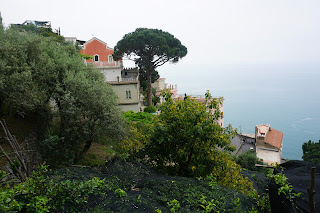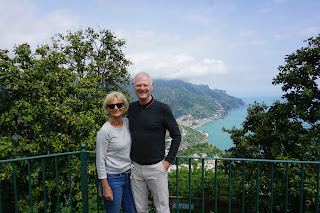A Day on Gozo
Gozo is a small island (1/3 the size of Malta) that is accessible by a 20 minute ferry ride. The island is part of Malta but the 30,000 locals consider themselves Gozitans first. We took a taxi to the northern tip of Malta to catch the ferry and had booked a private jeep tour of Gozo. It was a beautiful sunny day and we had a very knowledgeable guide in Ken who spoke excellent English. We covered a lot of ground and saw most of the island in our six hour tour and thoroughly enjoyed the experience. We took the ferry back to Malta and decided to take the bus back to Valletta which took 90 minutes instead of the 50 minute taxi ride.
Unloaded from the ferry at lovely Mgaar Harbor with the Church of our Lady of Lourdes (built in 1893) sitting on a promitory overlooking the harbor.
Gozo is much greener and a lot more pastoral than Malta.
Looking down at Ramla Bay with its beautiful sandy beach and colorful blue Mediterranean waters
These working salt pans on Xwieni Bay are over 350 years old and stretch 3km along the coast but salt has been harvested here since the Phoenicians. Sea water is poured into the pans and after the water has evaporated the salt is harvested and sold.
The huge church towering over the open countryside is the Basilica of the National Shrine of the Blessed Virgin of Ta' Pinu and was completed in 1932.
The towering Dwerja Cliffs and Fungus Rock on the west coast of Gozo. A rare brown plant that looks like a fungus and was believed to have powerful pharmaceutical qualities was found on this rock. The rock was secured by the Knights of St. John and the plant was harvested for use in their hospitals and sold at high prices to various courts in Europe.
The Inland Sea is a cliff bound lagoon connected to the open sea by a tunnel that runs a 100m through the rock. The tunnel is big enough for small boats to sail through in calm weather and the Inland Sea has been used as a fishermen's haven for centuries. Today fishermen supplement their income by taking tourist of boat trips through the tunnel.
Unloaded from the ferry at lovely Mgaar Harbor with the Church of our Lady of Lourdes (built in 1893) sitting on a promitory overlooking the harbor.
Gozo is much greener and a lot more pastoral than Malta.
Looking down at Ramla Bay with its beautiful sandy beach and colorful blue Mediterranean waters
These working salt pans on Xwieni Bay are over 350 years old and stretch 3km along the coast but salt has been harvested here since the Phoenicians. Sea water is poured into the pans and after the water has evaporated the salt is harvested and sold.
The huge church towering over the open countryside is the Basilica of the National Shrine of the Blessed Virgin of Ta' Pinu and was completed in 1932.
The towering Dwerja Cliffs and Fungus Rock on the west coast of Gozo. A rare brown plant that looks like a fungus and was believed to have powerful pharmaceutical qualities was found on this rock. The rock was secured by the Knights of St. John and the plant was harvested for use in their hospitals and sold at high prices to various courts in Europe.
The Inland Sea is a cliff bound lagoon connected to the open sea by a tunnel that runs a 100m through the rock. The tunnel is big enough for small boats to sail through in calm weather and the Inland Sea has been used as a fishermen's haven for centuries. Today fishermen supplement their income by taking tourist of boat trips through the tunnel.









Comments
Post a Comment